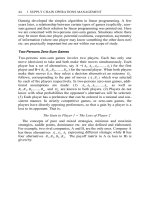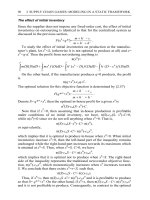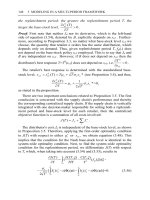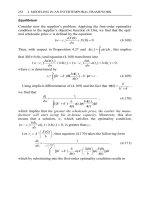Operations management heizer 6e ch13
Bạn đang xem bản rút gọn của tài liệu. Xem và tải ngay bản đầy đủ của tài liệu tại đây (328.22 KB, 65 trang )
Operations
Management
Chapter 13 –
Aggregate Planning
PowerPoint presentation to accompany
Heizer/Render
Principles of Operations Management, 6e
Operations Management, 8e
© 2006
Prentice
Hall, Inc. Hall, Inc.
©
2006
Prentice
13 – 1
Outline
Global Company Profile:
Anheuser-Busch
The Planning Process
The Nature Of Aggregate Planning
Aggregate Planning Strategies
Capacity Options
Demand Options
Mixing Options to Develop a Plan
© 2006 Prentice Hall, Inc.
13 – 2
Outline – Continued
Methods For Aggregate Planning
Graphical and Charting Methods
Mathematical Approaches to
Planning
Comparison of Aggregate Planning
Methods
© 2006 Prentice Hall, Inc.
13 – 3
Outline – Continued
Aggregate Planning In Services
Restaurants
Hospital
National Chains of Small Service
Firms
Miscellaneous Services
Airline Industry
Yield Management
© 2006 Prentice Hall, Inc.
13 – 4
Learning Objectives
When you complete this chapter, you
should be able to:
Identify or Define:
Aggregate planning
Tactical scheduling
Graphic technique for aggregate
planning
Mathematical techniques for
aggregate planning
© 2006 Prentice Hall, Inc.
13 – 5
Learning Objectives
When you complete this chapter, you
should be able to:
Describe or Explain:
How to do aggregate planning
How service firms develop
aggregate plans
© 2006 Prentice Hall, Inc.
13 – 6
Anheuser-Busch
Anheuser-Busch produces nearly 40% of
the beer consumed in the U.S.
Matches fluctuating demand by brand to
plant, labor, and inventory capacity to
achieve high facility utilization
High facility utilization requires
Meticulous cleaning between batches
Effective maintenance
Efficient employees
Efficient facility scheduling
© 2006 Prentice Hall, Inc.
13 – 7
Aggregate Planning
Determine the quantity and timing of
production for the immediate future
Objective is to minimize cost over the
planning period by adjusting
Production rates
Labor levels
Inventory levels
Overtime work
Subcontracting
Other controllable variables
© 2006 Prentice Hall, Inc.
13 – 8
Aggregate Planning
Required for aggregate planning
A logical overall unit for measuring
sales and output
A forecast of demand for intermediate
planning period in these aggregate units
A method for determining costs
A model that combines forecasts and
costs so that scheduling decisions can
be made for the planning period
© 2006 Prentice Hall, Inc.
13 – 9
The Planning Process
Long-range plans
(over one year)
Research & Development
New product plans
Capital investment
Facility location/expansion
Top
executives
Operations
managers
Intermediate-range plans
(3 to 18 months)
Sales planning
Production planning and budgeting
Setting employment, inventory,
subcontracting levels
Analyzing cooperating plans
Short-range plans
(up to 3 months)
Operations
managers,
supervisors,
foremen
Responsibility
© 2006 Prentice Hall, Inc.
Job assignments
Ordering
Job scheduling
Dispatching
Overtime
Part-time help
Planning tasks and horizon
Figure 13.1
13 – 10
Aggregate Planning
Jan
150,000
Quarter 1
Feb
120,000
Apr
100,000
Mar
110,000
Quarter 2
May
130,000
Jul
180,000
© 2006 Prentice Hall, Inc.
Jun
150,000
Quarter 3
Aug
150,000
Sep
140,000
13 – 11
Aggregate Planning
Marketplace
and
demand
Demand
forecasts,
orders
Product
decisions
Process
planning and
capacity
decisions
Workforce
Aggregate
plan for
production
Master
production
schedule and
MRP
systems
Detailed
work
schedules
© 2006 Prentice Hall, Inc.
Research
and
technology
Raw
materials
available
External
capacity
(subcontractors)
Inventory
on
hand
Figure 13.2
13 – 12
Aggregate Planning
Combines appropriate resources
into general terms
Part of a larger production planning
system
Disaggregation breaks the plan
down into greater detail
Disaggregation results in a master
production schedule
© 2006 Prentice Hall, Inc.
13 – 13
Aggregate Planning
Strategies
1. Use inventories to absorb changes in
demand
2. Accommodate changes by varying
workforce size
3. Use part-timers, overtime, or idle time to
absorb changes
4. Use subcontractors and maintain a stable
workforce
5. Change prices or other factors to
influence demand
© 2006 Prentice Hall, Inc.
13 – 14
Capacity Options
Changing inventory levels
Increase inventory in low demand
periods to meet high demand in
the future
Increases costs associated with
storage, insurance, handling,
obsolescence, and capital
investment
Shortages can mean lost sales due
to long lead times and poor
customer service
© 2006 Prentice Hall, Inc.
13 – 15
Capacity Options
Varying workforce size by hiring
or layoffs
Match production rate to demand
Training and separation costs for
hiring and laying off workers
New workers may have lower
productivity
Laying off workers may lower
morale and productivity
© 2006 Prentice Hall, Inc.
13 – 16
Capacity Options
Varying production rate through
overtime or idle time
Allows constant workforce
May be difficult to meet large
increases in demand
Overtime can be costly and may
drive down productivity
Absorbing idle time may be
difficult
© 2006 Prentice Hall, Inc.
13 – 17
Capacity Options
Subcontracting
Temporary measure during
periods of peak demand
May be costly
Assuring quality and timely
delivery may be difficult
Exposes your customers to a
possible competitor
© 2006 Prentice Hall, Inc.
13 – 18
Capacity Options
Using part-time workers
Useful for filling unskilled or low
skilled positions, especially in
services
© 2006 Prentice Hall, Inc.
13 – 19
Demand Options
Influencing demand
Use advertising or promotion to
increase demand in low periods
Attempt to shift demand to slow
periods
May not be sufficient to balance
demand and capacity
© 2006 Prentice Hall, Inc.
13 – 20
Demand Options
Back ordering during highdemand periods
Requires customers to wait for an
order without loss of goodwill or
the order
Most effective when there are few
if any substitutes for the product
or service
Often results in lost sales
© 2006 Prentice Hall, Inc.
13 – 21
Demand Options
Counterseasonal product and
service mixing
Develop a product mix of
counterseasonal items
May lead to products or services
outside the company’s areas of
expertise
© 2006 Prentice Hall, Inc.
13 – 22
Aggregate Planning Options
Option
Advantages
Disadvantages
Some Comments
Changing
inventory
levels
Changes in
Inventory
human
holding cost
resources are
may increase.
gradual or
Shortages may
none; no abrupt result in lost
production
sales.
changes
Applies mainly to
production, not
service,
operations
Varying
workforce
size by
hiring or
layoffs
Avoids the costs Hiring, layoff,
of other
and training
alternatives
costs may be
significant
Used where size
of labor pool is
large
Table 13.1
© 2006 Prentice Hall, Inc.
13 – 23
Aggregate Planning Options
Option
Advantages
Disadvantages
Some Comments
Allows flexibility
within the
aggregate plan
Varying
production
rates
through
overtime or
idle time
Matches
seasonal
fluctuations
without hiring/
training costs
Overtime
premiums; tired
workers; may
not meet
demand
Subcontracting
Permits
flexibility and
smoothing of
the firm’s
output
Loss of quality
Applies mainly in
control;
production
reduced profits; settings
loss of future
business
Table 13.1
© 2006 Prentice Hall, Inc.
13 – 24
Aggregate Planning Options
Option
Advantages
Disadvantages
Some Comments
High turnover/
training costs;
quality suffers;
scheduling
difficult
Good for
unskilled jobs in
areas with large
temporary labor
pools
Using parttime
workers
Is less costly
and more
flexible than
full-time
workers
Influencing
demand
Tries to use
Uncertainty in
excess
demand. Hard
capacity.
to match
Discounts draw demand to
new customers. supply exactly.
Creates
marketing
ideas.
Overbooking
used in some
businesses.
Table 13.1
© 2006 Prentice Hall, Inc.
13 – 25









